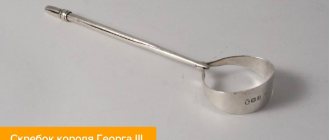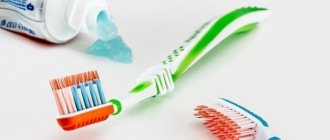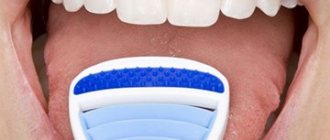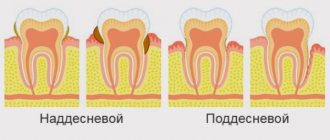- Why do you need to clean your tongue?
- How to clean your tongue
- How to clean your tongue
For many people, oral hygiene ends with brushing their teeth. However, cleaning your tongue is also necessary and important. Plaque and bacteria accumulate on it, from which caries develops and an unpleasant odor appears.
Regular tongue cleaning helps to avoid diseases such as stomatitis, gingivitis, caries and even periodontitis. Now we will look in detail at why you should clean your tongue and how to do it correctly and effectively.
Plaque on the tongue: normal or pathological
The tongue is a muscular organ in the oral cavity that performs a number of functions.
First of all, this is the determination of taste, speech, as well as mixing food in the mouth and pushing it into the esophagus. Even in ancient times, doctors noticed an interesting feature. It turns out that color, shape and other changes in the tongue often occur as a result of pathological changes in the body, in particular in the gastrointestinal tract. Therefore, during a physical examination, doctors often ask patients to stick out their tongue. The appearance of this organ is very informative for the doctor.
The normal color of the tongue mucosa is pale pink. Depending on various circumstances, a slight white coating is allowed. In the warm season (late spring, summer) the coating is thicker, and in cold time it is thinner. A slight yellowish tint of coating on the tongue is also considered a normal variant. In some cases, white and yellow plaque indicates diseases of the oral cavity, which are not difficult to cope with.
Please note that plaque on the tongue is not always caused by disease. If the tongue is coated, then the following circumstances could lead to this:
- Insufficient oral hygiene . In such cases, a person is bothered not only by plaque on the tongue, but also on the teeth, as well as bad breath. To eliminate the problem, you just need to properly monitor the condition of your mouth and teeth.
- Dehydration and dry mouth . The tongue becomes coated if the body does not have enough water. Dry mouth is one of the symptoms of dehydration. In such cases, little saliva is produced, which is why plaque appears. Dry mouth is often caused by not drinking enough fluids. Sometimes dehydration indicates diabetes mellitus, in which the body loses a lot of fluid due to forced diuresis.
- Bad habits . It is common for smokers and those who like to chew tobacco to have a coating on their tongue. As soon as you say goodbye to the bad habit, the problem will disappear. The same is true for persons who abuse alcoholic beverages.
- Breathing disorders . If a person has impaired nasal breathing (for example, due to a deviated nasal septum) or often breathes through the mouth, this contributes to the appearance of plaque on the tongue.
- Nutritional Features . When eating mainly soft foods, vegetable or fruit purees, the likelihood of plaque on the tongue increases.
- Taking certain medications . For example, with long-term use of antibacterial drugs, the microflora of the oral cavity is disrupted. This contributes to the appearance of a fungal infection, one of the symptoms of which is a coating on the tongue.
It is easy to notice that there is almost no plaque at the tip, while the largest layer is noted at the root of the tongue. This is due to the fact that the tip of the tongue is movable, and the base and basal region comes into contact only with the palate.
Cooking tongue in a slow cooker
How to clean a boiled pork tongue will be described in detail below.
And at the moment, a successful method of preparing it in an automatic pressure cooker is outlined. When the product is prepared in a slow cooker, the cooking time is significantly reduced. Traditionally, it is no more than 1 hour.
Almost all housewives prefer this cooking method, because it does not require any additional effort. The whole process happens automatically, and there is no need to watch the time.
Before cooking, the tongue should be poured with boiling water and covered with at least 2 cm of water.
Experienced housewives recommend marinating the product in garlic and spices before cooking in a slow cooker.
Then put it and its contents in a bag and leave it in the refrigerator overnight.
After stewing, the cooked tongue becomes tender and aromatic.
What pathologies cause plaque on the tongue?
Since the tongue is inextricably linked with the digestive organs, the appearance of plaque often indicates diseases of the gastrointestinal tract. However, there are other diseases in which the tongue becomes coated. Consider these diseases:
- Gastritis . The most common cause of abundant white coating on the tongue is gastritis. At the same time, the tongue is covered with different types of gastritis - autoimmune, hemorrhagic, chronic atrophic gastritis, as well as gastritis with low acidity.
- Bulbit . This is an inflammatory disease of the duodenum. Bulbitis is characterized by both acute and chronic course. In this case, inflammation in this pathology can be focal (local) or diffuse. Most often, with bulbitis, the tongue becomes covered with a white or yellowish coating.
- Gallbladder diseases . The tongue with biliary dyskinesia and cholelithiasis also becomes white or yellowish.
- Duodenitis . This is an inflammatory pathology of the duodenum. With duodenitis, erosions appear in the intestines, and the intestinal glands are also affected.
- Sore throat (acute tonsillitis) . This is an acute inflammation of the tonsils, accompanied by fever and often a white purulent coating on the tonsils and tongue.
- Thrush (candidiasis) . A fungal disease caused by bacteria from the genus Candida is known as thrush. Candidiasis affects not only the urogenital tract, but also the oral cavity. Thrush is characterized by an abundant white, cheesy coating on the tongue.
- Glossitis . This is an inflammation of the tongue, most often caused by pathogenic microorganisms or injury. The coating on the tongue with glossitis is white, yellowish or grayish, depending on the type of pathology. Ulcerative glossitis is also characterized by the appearance of bad breath.
- STD . Sexually transmitted diseases are also sometimes accompanied by heavy plaque, especially on the root of the tongue. Such manifestations are possible with syphilis or HIV infection, against the background of which there is a decrease in immune status.
- Diabetes . With an increase in the concentration of glucose in the blood, opportunistic and pathogenic microflora are activated. The risk of infections, including in the oral cavity, increases. In addition, diuresis increases with diabetes. The patient is bothered by a frequent urge to urinate, which causes the body to lose fluid. This leads to dry mouth and plaque on the tongue.
- Diarrhea and vomiting . These are symptoms of many diseases. With diarrhea and vomiting, dehydration also occurs, which contributes to the appearance of white plaque.
Plaque on the tongue also appears with a number of other infectious and inflammatory pathologies, chronic diseases and lack of vitamins. However, such a symptom is not specific to any disease. In other words, a patient cannot be diagnosed based on plaque on the tongue alone. A coated tongue only allows the doctor to assume the presence of a disease, but not to diagnose it based on this symptom alone.
Folk remedies
How to clean white plaque from your tongue at home?
For this purpose, you can use proven folk recipes: Vegetable oil. To cleanse your tongue, just take a little vegetable oil into your mouth and rinse it thoroughly. This procedure should last at least 10 minutes. Used oil should not be swallowed. If necessary, the manipulations should be repeated.
Soda. If thick plaque appears, you need to use a warm soda solution.
It is important to monitor the temperature, since a cold solution will not get rid of plaque and may even damage the tongue. To cleanse, take 3 small spoons of baking soda and mix with warm water.
Use the resulting solution for rinsing. You can also soak a brush in baking soda and clean your tongue. Finally, you should rinse your mouth with plain water or a special product.
Propolis. This product has pronounced antiseptic properties. Alcohol tincture of propolis is sold in every pharmacy. To prepare a useful product, you need to add a few drops of the product to a glass of water. You should rinse your mouth with the resulting liquid after every meal. It is also very useful to chew a small piece of propolis. This must be done within 5 minutes.
Aloe. This product has anti-inflammatory properties, copes with bacterial microorganisms and eliminates bad breath. To cleanse your tongue, take 1 small spoon of aloe juice, rinse your mouth for a few minutes and spit it out. Then you can drink 1 small spoon of juice. It is recommended to use this product for 2 weeks.
Salt. This product has a rough texture and helps remove dead cells and food particles. In addition, salt has antiseptic properties and helps fight bacteria. To use the product, simply place a pinch of salt on your tongue and brush it for a minute. Rinse your mouth with warm water. This should be done 2 times a day to get good results.
Turmeric. This spice has pronounced antibacterial characteristics and prevents the development of bacterial microorganisms. To cleanse your tongue, mix half a small spoon of turmeric with lemon juice to obtain a paste consistency. Rub the product into your tongue for several minutes. Then rinse your mouth with warm water.
Lemon juice. It contains elements that can cope with fungal and bacterial microorganisms. To do this, rinse your mouth with lemon juice for 5 minutes.
Hydrogen peroxide. This remedy helps to cope with fungi and bacteria that accumulate on the tongue. To do this, take a glass of water and add a small spoon of peroxide. Use the prepared solution for rinsing.
Boric acid. This substance helps to cope with white plaque. Making a rinse solution is very simple: you need to take a cup of water and add a quarter of a small spoon of acid. The ingredients should be mixed thoroughly and used for rinsing.
Garlic. Chewing this product is considered a very simple and affordable way to combat plaque. The product has antifungal properties and helps remove bacteria. It can be added to food or used in its pure form.
A white coating on the tongue can indicate a variety of pathologies. To cope with the problem, you need to identify the provoking factor.
To cleanse the tongue, you can use special products and effective folk recipes.
Plaque on a child's tongue
Plaque on the tongue of a child, like an adult, occurs due to the above circumstances or diseases. Often the cause of plaque in a child is insufficient oral hygiene. Since children often suffer from acute respiratory viral infections, the tongue often becomes clogged with sore throats and other inflammatory diseases of the oropharynx.
White coating on the tongue of infants is also considered normal, since babies do not yet produce enough saliva to wash off the milky coating. If plaque appears frequently on your baby’s tongue, then this is a reason to consult a pediatrician. It is important to exclude possible pathological changes that can lead to such a symptom.
Diagnostics
Diagnosis is carried out to determine the true cause of plaque formation on the tongue. It involves an external examination of the affected organ, during which special attention is paid to the following circumstances:
- tongue color;
- plaque thickness;
- location of deposits;
- presence of disturbances in the functioning of the language.
Additionally, other measures are carried out, including an instrumental examination of the patient and analysis of urine and blood to determine the localization of the inflammatory process.
White coating on the tongue: why it appears and how to remove it
The most common is a white coating on the tongue, which most people experience. This is a layer of dead epithelial tissue, as well as bacteria and organic compounds, which acquire a whitish hue when deposited on the surface of the tongue.
The cause of plaque is inflammation of the papillae of the tongue. When inflamed, they become larger, which causes the space between the papillae to increase. In this space, dead tissue, bacteria and organic substances “get stuck”, forming a characteristic white coating.
In most cases, a small amount of white coating on the tongue does not indicate health problems. Often this symptom is temporary and is associated with poor oral hygiene, smoking, drinking alcohol, eating disorders and other circumstances.
In some cases, a white coating coats the tongue in diseases such as gastritis, thrush, tonsillitis, lichen planus, syphilis and others. Since plaque on the tongue is also considered a physiological norm, it is recommended to consult a doctor under the following circumstances:
- If there is too much white plaque.
- With frequent episodes of plaque on the tongue for no apparent reason (smoking, poor oral hygiene, etc.).
- For pain in the tongue or mouth, which is often associated with inflammatory pathologies.
- If plaque on the tongue is accompanied by other symptoms (usually gastrointestinal diseases), such as nausea, vomiting, abdominal pain, dizziness, diarrhea and others.
- If you experience dry mouth and increased urination. These symptoms are typical for diabetes.
- In cases where plaque on the tongue persists for several weeks.
Getting rid of plaque on your tongue is not difficult. To do this, it is enough to maintain oral hygiene. Remove plaque using a special tongue cleaner. Also, on many toothbrushes, the back side is presented in the form of a tongue scraper.
If the plaque is caused by pathologies, then you can get rid of the problem only after treatment. In some cases, getting rid of plaque is not so easy. For example, with a sore throat or thrush, the plaque becomes covered with a dense film, which makes it quite difficult to remove it mechanically.
Important! Maintain good oral hygiene.
Brush your teeth and tongue twice a day. This will help avoid a number of complications, in particular fungal and bacterial infections.
Nature of the raid
It has been established that certain parts of the tongue are associated with specific organs. A color change in the middle of the organ indicates problems with the stomach. A lesion on the tip of the tongue indicates problems with the intestines.
How to quickly remove plaque from your tongue
In addition, the left and right parts of the digestive organ are interconnected with the spleen and liver, respectively. And the formation of plaque on the central groove means that it is necessary to conduct an examination of the spine.
Also, after the appearance of a white tongue, you need to pay attention to the thickness of the plaque. If it is easy to remove, then the disease that caused this symptom is at the initial stage of development. When the plaque acquires a dense and thick consistency, and it becomes more difficult to get rid of it, then they speak of a chronic form of the pathology.
The color color indicates the severity of the pathological process: the lighter it is, the more mild the disease has affected the human body. The consistency of the plaque is as follows:
- wet;
- dry;
- curdled;
- fatty.
Before turning to the reasons for changes in the color of the tongue, it should be emphasized that the surface of the digestive organ becomes colored after consuming certain foods. This article discusses only those types of plaque that were caused by pathological processes in the body.
What else is there like a coating on the tongue?
In addition to white, in some cases the tongue is also covered with a coating of other colors. Let's take a closer look at what the color of plaque on the tongue means.
Yellow plaque
When a yellow coating appears on the tongue, the first thing you need to think about is the food that turns the tongue yellow. For example, these are citrus fruits, turmeric, curry and other foods and spices containing yellow pigments.
If you have not eaten yellow-colored foods, such plaque often occurs due to liver and gallbladder diseases. Be sure to consult your doctor, especially in cases where the plaque lasts for several days.
Sometimes a yellowish coating also occurs when dehydrated, but disappears within a day after quenching thirst.
White plaque with red spots
The presence of red spots on the tongue indicates an inflammatory process. This symptom indicates glossitis. With glossitis, the papillae of the tongue merge and form spots. Visually, such spots resemble continents with seas, which is why glossitis is also called geographic tongue.
With glossitis, in addition to plaque, the patient may also experience pain and discomfort when eating and drinking. Glossitis usually goes away within a few days. The only condition is to maintain oral hygiene. If the disease does not go away, then you should consult a dentist.
Orange plaque
An orange coating, like yellow, also forms after eating citrus fruits, turmeric and other fruits and spices of bright yellow or orange color. In addition, an orange coating on the tongue occurs with diseases of the liver, gall bladder, pathologies of the urinary system and disorders of the digestive system.
Brown plaque
As with yellow or orange plaque, the first thing to think about when brown plaque appears is the food you recently ate. The tongue acquires a brownish tint after drinking coffee, cocoa or chocolate, although under the influence of saliva in such cases the tongue quickly clears.
Long-term use of a number of medications (in particular, antibiotics) is another cause of a brownish coating on the tongue. As for diseases, brown plaque often occurs against the background of diseases of the gastrointestinal tract, excess mucus in the body, as well as stomatitis and kidney pathologies.
Black plaque
This is an extremely rare occurrence. Black plaque appears when the balance of microflora in the oral cavity is disturbed. Some types of opportunistic and pathogenic microbes, feeding on dead tissues of the oral cavity, deposit black waste products on the tongue.
The appearance of a black coating on the tongue is sometimes associated with pathologies of the liver, gall bladder or spleen. Contact your doctor immediately if this symptom occurs.
Grey colour
Appears with peptic ulcer of the duodenum and stomach. Accompanied by inflammation of the gums. A putrid odor and a dense serous coating on the mucous membrane indicate the chronic stage of gastroenteritis. Traditional medicine recommends the use of decoctions of medicinal plants: licorice root, bird cherry fruits, thyme, eucalyptus, chicory, rowan, sophora, rose hips and others. All of them have anti-inflammatory effects. You can brew the herb with boiling water and rinse your mouth several times a day.
How to get rid of plaque on your tongue
Depending on the color of deposits on the tongue, the duration of the symptom and a number of other circumstances, to get rid of plaque we recommend following the following recommendations:
- Maintain oral hygiene by using toothbrushes and tongue cleaner. This is enough if we are talking about periodically occurring white plaque.
- See your doctor if yellow, red, brown, black, or heavy white plaque appears. It is important to get diagnosed and eliminate the root cause of the disease.
- Use antibiotics and antifungal medications only as directed by your doctor. Antibiotics are prescribed when the bacterial nature of the disease is established (for example, with a sore throat), and antifungals are prescribed for fungal pathologies (for example, with thrush).
- During treatment procedures, avoid consuming sweets and alcoholic beverages.
FAQ
How to get rid of plaque?
Maintain good oral hygiene. If the plaque does not go away within a few days, consult a doctor. The true cause of the plaque must be determined and appropriate treatment carried out.
What does white coating on the tongue mean? Is this normal or pathological?
In most cases, this is the norm. White plaque also occurs in a number of diseases. If plaque appears frequently while maintaining oral hygiene, then it is quite possible that the problem lies in a disruption of the gastrointestinal tract. The most common cause in this case is gastritis.
Do I need to clean my tongue?
Just like your teeth, your tongue needs regular care. Just don't clean your tongue with a brush. The stubble will damage the papillae of the tongue, causing inflammation. Use special tongue cleaners.











